Habelia, a fossil predator with a “multi-tool” head
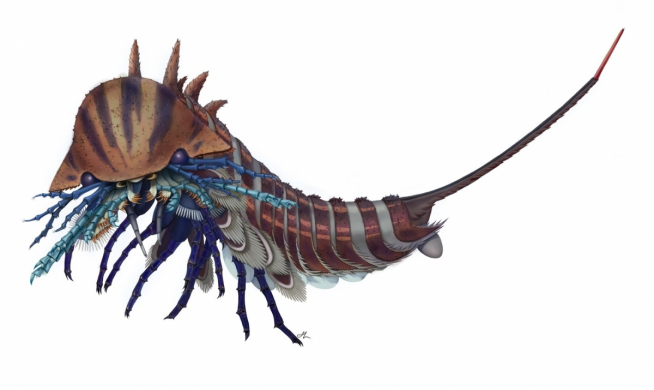
By Cédric Aria
Post-doctoral researcher, currently at the Nanjing Institute of Geology and Palaeontology
The rare animal Habelia optata, which had originally been described in 1912, had remained one of the most problematic fossils from the middle Cambrian Burgess Shale—the 508 million years old exceptional fossil deposit of British Columbia (see Habelia optata on the ROM Burgess Shale website for an overview). Our new study is part of a wider reappraisal of Burgess Shale arthropods—invertebrate animals with segmented and articulated bodies—, which I had worked on as part of my doctoral degree at the University of Toronto/Royal Ontario Museum (ROM). My former supervisor Jean-Bernard Caron, senior curator of invertebrate paleontology at the ROM and I, have now redescribed this species in detail mainly based on abundant new material housed at the ROM and also the original Walcott collection at the National Museum of Natural History in Washington, D.C.
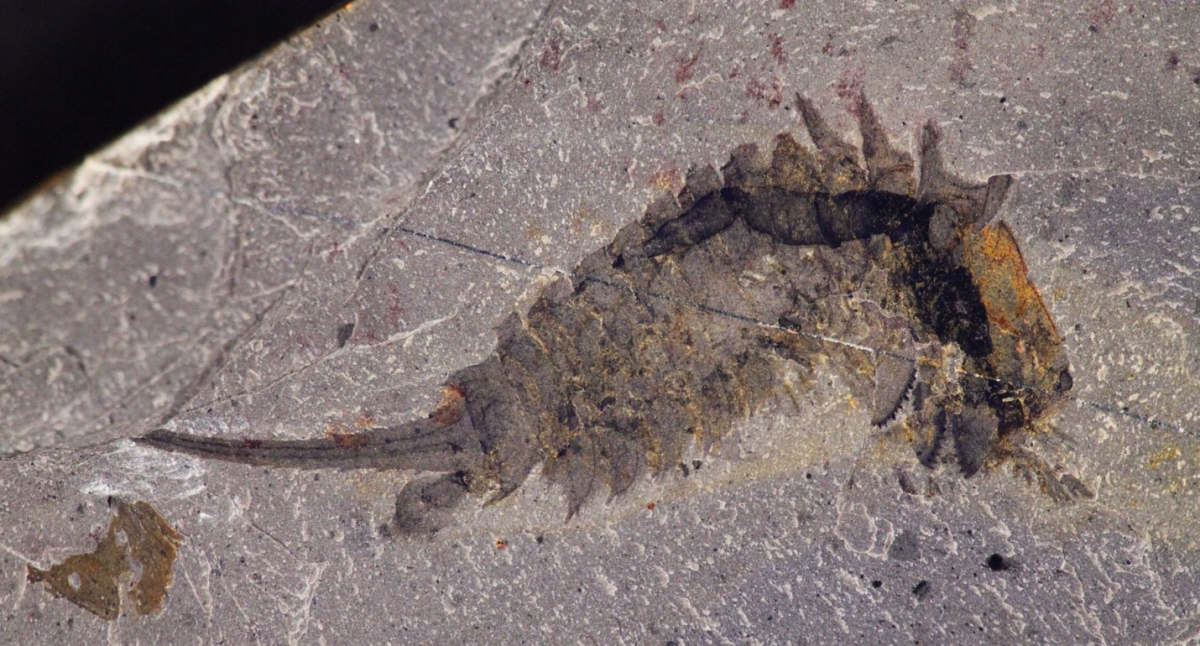
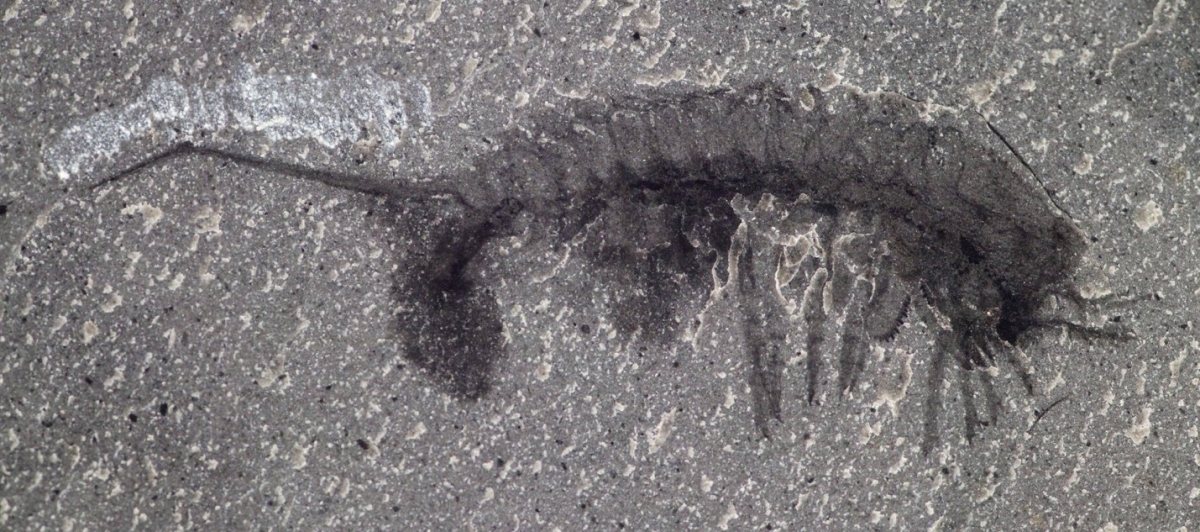
This is a small specimen showing the long, bipartite tailpiece (on the left) and most of the appendages in great detail—including jaws with long teeth under the head shield. The ramified projections at the very front (right) are interpreted as the partially "detached" outer branches of the head appendages. ROMIP64357.
Joanna Liang was then tasked to work on detail technical drawings, including 3D animations, as part of her Master of Science in Biomedical Communications, a program offered through the Institute of Medical Science in the Faculty of Medicine at the University of Toronto. The process took close to 18 months of back and forth between us, the palaeontologists and the illustrator, to ultimately yield what could be seen as one of the most technically challenging 3D reconstruction of a Cambrian animal, among those described thus far.
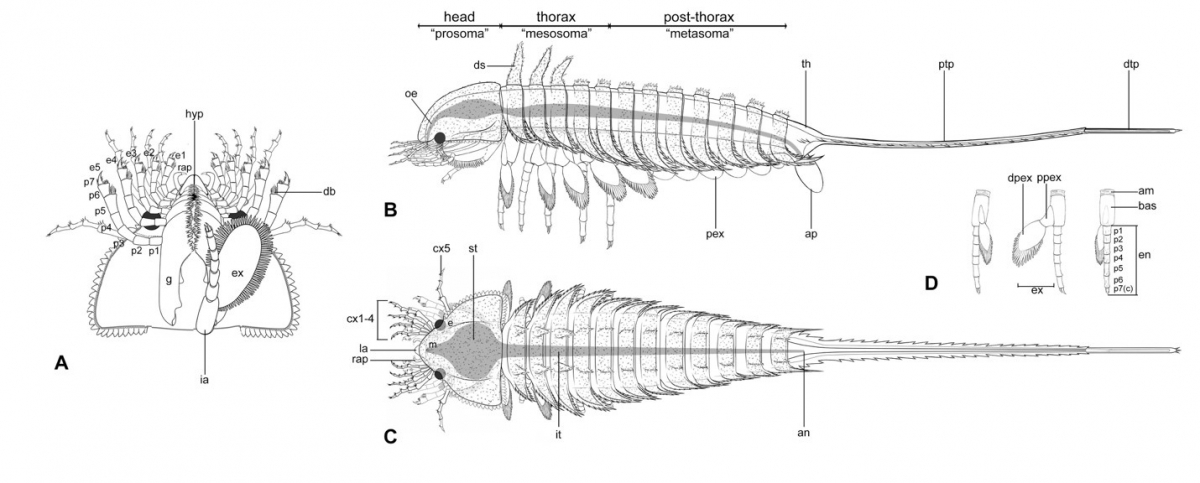
Detailed diagrams of Habelia optata (type A). A. Ventral view of the head. Right posterior appendage removed to show the morphology of the jaws ("gnathobases"). B. Lateral view. C. Dorsal view. D. Isolated limbs of the thorax in frontal, lateral and posterior views (left to right).
Animation of Habelia optata - Head, jaws, and limbs. Demonstrating the complexity of its feeding mechanism Credit: Animated by Joanna Liang, © Royal Ontario Museum
Animation of Habelia optata - 360 view. Illustrating the spectacular architecture of its body. Credit: Animated by Joanna Liang, © Royal Ontario Museum
Short film showing the process of reconstructing Habelia optata—from fossil observations to the 3D model. Credit: Animated by Joanna Liang, © Royal Ontario Museum
An ancient relative of chelicerates… looking like a mandibulate
In brief, the extremely complex head of Habelia formed a surprisingly efficient sensory, raptorial and masticatory device suited to a durophagous diet (diet based on hard carapaces and shells). We interpreted the species as an active predator that lived at the bottom of the Cambrian seas and hunted small preys, possibly including small trilobites. Our study shows that Habelia optata belongs to chelicerates, one of the two main groups of modern arthropods (including spiders, scorpions, horseshoe crabs, mites) and illustrates a spectacular and unique morphological convergence with species of the other sub-group of modern arthropods: the mandibulates (including shrimps, crabs, centipedes, insects). Morphological convergence is a phenomenon that involves the evolution of similarities between features, despite different origins, usually because they fulfill comparable functions. Wings in pterosaurs, bats and birds, for instance, are convergent since they have evolved independently in each of these groups.
Convergence goes even further in Habelia, because functional similarities with mandibulates mostly evolved from different limbs.

Figure showing convergent evolution of head features between Habelia (A) and predatory mandibulates (B: isopod, C: centipede). Although these traits in Habelia had a different evolutionary origin, they fulfilled similar functions. Green: sensory/tactile; Orange: masticatory; Blue: holding/manipulating.
An armoured, mobile and efficient body
Habelia optata is a well-armoured arthropod of about 2 cm in length with a tail as long as the rest of the body, and made of two articulated pieces. Its exoskeleton is covered in numerous blunt spines/tubercles and long spines also adorn the back behind the head.
The body is divided into head, thorax and post-thorax (that is, not an abdomen in the technical sense). The head is particularly complex and contains three different types of appendages: a reduced anteriormost pair thought to be the precursor of chelicerae; a series of five pairs of highly modified appendages fulfilling various functions, and a seventh, posteriormost, larger pair. The appendages in the series of five are made of: a large plate with teeth (gnathobase) for mastication; a leg-like branch with setae and spines for grasping; and an elongate, slender branch modified as a sensory/tactile appendage. This sensory branch is not fully "attached" to the rest of the appendage as it should be (how it is attached to the head is not known), a very peculiar condition in arthropods.
The thorax bears five pairs of biramous walking legs. The post-thorax bears rounded appendages likely used in respiration.
What happened?
Among chelicerates are very familiar animals: spiders, scorpions, harvestmen, mites and horseshoe crabs. They are united by a head bearing five pairs of legs and an anteriormost pair of chelate appendages used to cut their food: the chelicerae. These traits distinguish them from the other large group of modern arthropods, the mandibulates—such as shrimps, crabs, centipedes or insects—which by contrast have sensorial antennae and modified head limbs assisting in food mastication. Mandibulates that feed on other arthropods or shelly animals in particular (i.e. that are durophagous), such as lobsters, crabs or centipedes, usually have these head appendages forming series of plates (and especially the mandibles), providing them with strong crushing abilities.
In revisiting Habelia optata, notably with the help of unpublished fossil material from the Royal Ontario Museum, we found that this long problematic arthropod from the Burgess Shale was in fact a close relative of the ancestor of all chelicerates. Although they do not seem to form pincers, the anteriormost limbs of Habelia are small and distinct from a series of five other pairs of head appendages, and hence likely ancestral forms of the chelicerae. A seventh pair of appendages at the back of the head also helps explain the origin of corresponding modified structures in chelicerates, such as the small appendages called "chilaria" in horseshoe crabs.
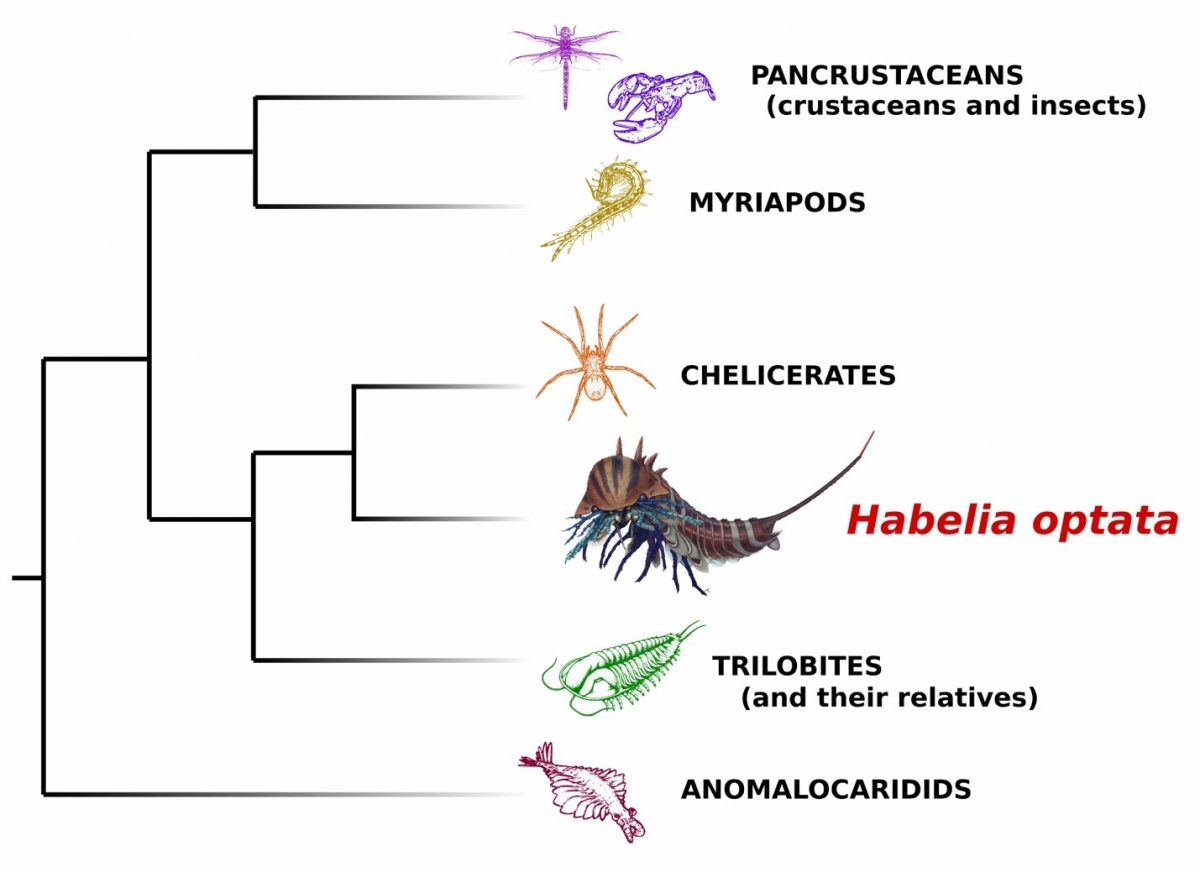
Simplified phylogeny ('tree of life') showing the relationship of Habelia with other groups of arthropods. The study shows that it is an early relative of chelicerates — a group including spiders, scorpions, horseshoe crabs and mites.
However, we also found that Habelia converged remarkably with durophagous mandibulates: the head appendages behind the "proto-chelicerae" are smaller and not walking legs, but spinose and raptorial, and are attached to exceptionally large masticating plates called gnathobases. Unlike horseshoe crabs for instance, these plates overlap and close parallel to the ventral surface of the head—much as in mandibulates. The outer branches of these appendages (exopods), absent in modern chelicerates, are here present and modified into slender sensory apparatuses, recalling the antennae of mandibulates. Furthermore, the seventh pair of appendages at the back of the head seems to have fulfilled a function analog to that of the maxillipeds—additional appendages in mandibulates assisting the other head limbs in the processing of food.
It is important to note that these resemblances are not entirely due to the proximity of Habelia to the point of divergence between chelicerates and mandibulates: they are in part secondary modifications of features that were already characteristically chelicerate in nature. Combined with other pieces of evidence, such as the high number of head appendages, the modifications of limb branches into pseudo-antennae, and the shape of trunk segments, this suggests that the origin of chelicerates was marked by a remarkable morphological plasticity.
From this outstanding head structure, as well as from well-developed walking legs in its trunk, we can picture Habelia and its relatives (known from less complete remains in the USA and Australia) as small active predators of the Cambrian sea floors, hunting for small or immature trilobites and other shelly animals. This builds onto the importance of carapaces and shells for evolutionary change during the Cambrian Explosion, and expands our understanding of ecosystems at this time, showing another level of predator-prey relationship and its determining impact on the rise of modern arthropods.
Link to paper (freely accessible): https://bmcevolbiol.biomedcentral.com/articles/10.1186/s12862-017-1088-7
In the News
http://www.cbc.ca/news/technology/habelia-fossil-burgess-shale-1.4460279
Learn more about the Burgess Shale:
